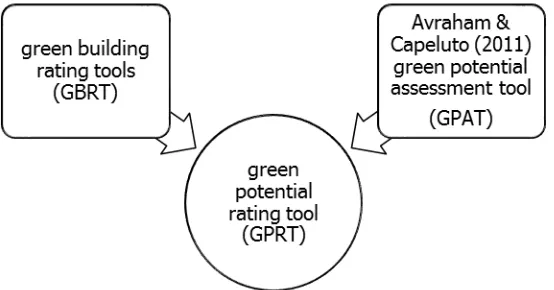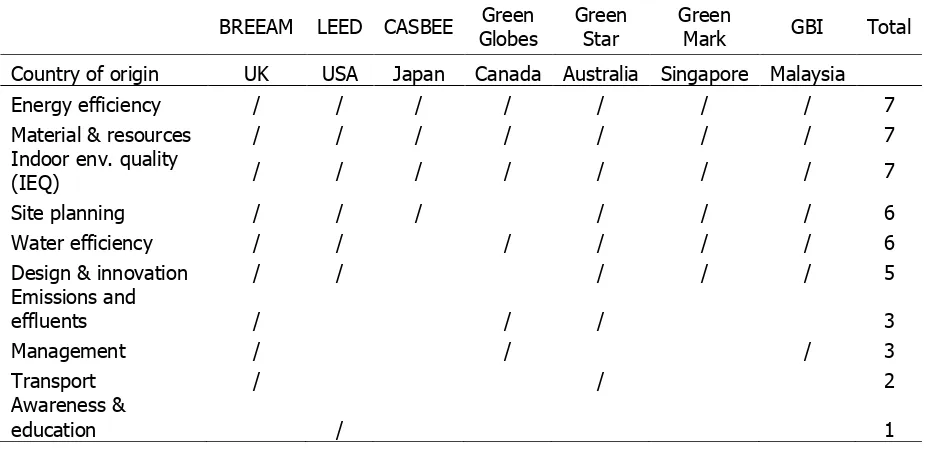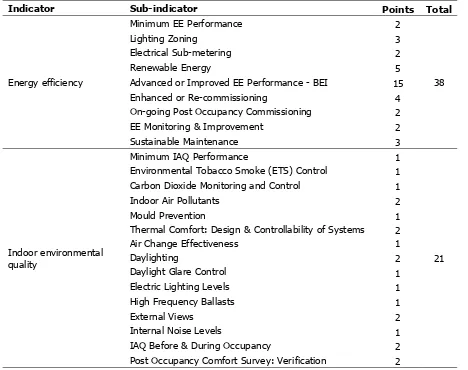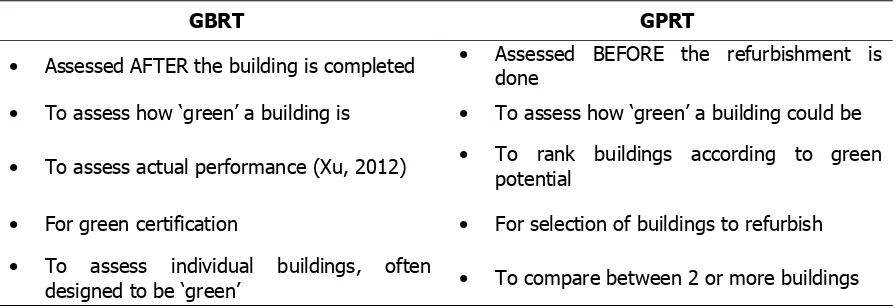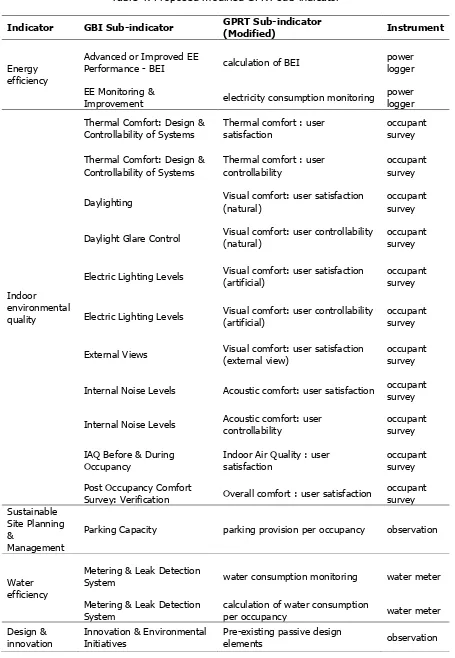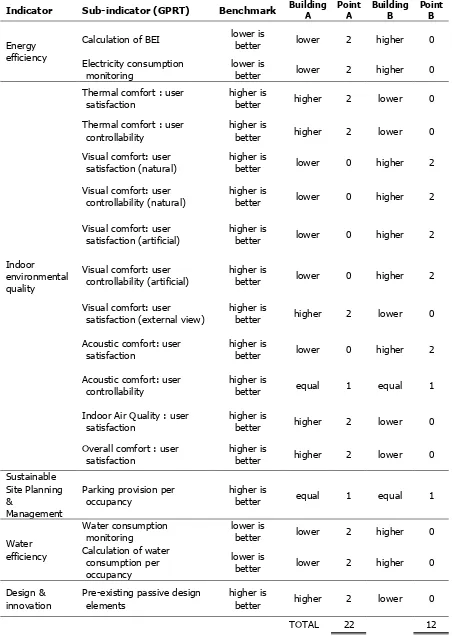GREEN BUILDINGS IN CAMPUS: AN ASSESSMENT OF GREEN
POTENTIAL FOR EXISTING CONVENTIONAL BUILDINGS
S.N.N. Syed Yahya, A.R.M. Ariffin, M.A. Ismail
Department of Architecture, Faculty of Built Environment, University of Malaya, 50603, Kuala Lumpur, Malaysia
Urban and Conservation Tropical Architecture Centre, Faculty of Built Environment, University of Malaya, 50603, Kuala Lumpur, Malaysia
Corresponding author: S.N.N. Syed Yahya, Department of Architecture, Faculty of Built Environment, University of Malaya, 50603, Kuala Lumpur, Malaysia
Tel: +6016-2090887 Email: shipah79@gmail.com
Abstract
Refurbishing conventional buildings into green buildings can increase campus sustainability alongside building new sustainable buildings. However, refurbishing all campus’ buildings is impractical, uneconomical and involves thorough planning and prioritisation. Unlike other concepts of assessment, assessing the green potential of a conventional building is rarely discussed in past literature. Therefore, this paper presents the development of a conceptual framework for prioritising buildings that can be refurbished by assessing their green potentials. Through this paper, this concept will be discussed in depth by reviewing relevant literature on existing assessment tools. The review focuses on identifying methods and indicators that can be adopted for the assessment of green potential. The study discovers that while literature on green potential assessment is limited, the frameworks of other types of assessments concerning green buildings are still viable. It is found that the most suitable indicators can be derived from commercial green building rating tools with some modifications to produce evidence that can be collected and measured. This paper anticipates that apart from filling the gap in knowledge, these findings will assist the government, campus administrators and managers to strategize their efforts towards achieving campus sustainability.
Introduction
As a centre for knowledge, the university holds a crucial position in disseminating and promoting sustainability (Cusick 2009; Lukman & Glavic 2007; Rappaport & Creighton 2007, p. 14; Rusinko 2010). M'Gonigle and Starke (2006, p. xv), in their book, stated their frustration that although sustainability is preached in faculties, there still exist an ominous gap where the universities allow its environment to degrade in order to make way for physical development. In view of this, it is imperative to narrow the gap between what universities preach and what universities do M'Gonigle and Starke (2006, p. xv). Universities need to be sustainable in every attribute; economic, social and environment.
A large pool of literature regards university campuses as a ‘small city’ for their area, population size and their resources (Hoe 2011, p. 11; Mat et al. 2009). The combined population of 500,000 in Malaysia public universities alone qualify the universities as a state growth conurbation population where the largest university reaches 40,000 and qualifies as a major settlement centre (Department of Town and Country Planning 2012). A recent report by Ministry of Energy, Green Technology and Water (2011) shows that public universities are the biggest electricity consumer in comparison with other public buildings. The average consumption of 21,758,470 KWh per university is equivalent to the consumption of 2,112 residential homes (US Environmental Protection Agency 2013). These alarming figures signal that it is time to expedite and intensify efforts towards sustainable campuses.
One of the approaches towards campus sustainability is through green refurbishment. Not a new concept, green refurbishment has been proposed nearly two decades ago (Keeping & Shiers 1996), stemmed from the idea that existing conventional buildings can be refurbished into green buildings or made sustainable by integrating more environmentally conscious qualities into them. During the late 1880’s, demolishing and rebuilding old buildings were a rampant practice in the UK (Power 2010). However, since studies reveal that green refurbishment produces less carbon footprint in comparison with demolishing and rebuilding (Burton & Kesidou 2005; Chileshe, Khatib & Farah 2013; Durmus-Pedini & Ashuri 2010; Juan, Gao & Wang 2010; Ma et al. 2012), green refurbishment has gained popularity in the built environment (Power 2010; Thomsen & van der Flier 2009). Commonly, green refurbishments are implemented on small and single projects such as office floors or residential homes (ACF 2009; Wall & Shea 2013). While these modest efforts are plausible, green refurbishment of building stocks such as the university campus provides a more promising impact.
Green refurbishment is also favourable as it creates opportunities to incorporate sustainability strategies together with other types of building improvements (Mickaityte et al. 2008; Santamouris & Dascalaki 2002). This way, the benefit reaped from a green refurbishment is twofold.
While the benefits of green refurbishment is evident, implementing it on the entire campus’ building stock instantaneously is impractical and uneconomic (Olanrewaju 2011). University campuses are often composed of clusters of conventional buildings. The mass of buildings to undertake, financial inadequacy and space constraint, are among various factors that hamper the implementation of simultaneous green refurbishment throughout university campuses. This exercise requires thorough planning and prioritisation.
Refurbishment projects should be implemented in phases and should be prioritised according to each building’s potential on becoming a green building, or, its ‘green potential’ (Ben Avraham & Capeluto 2011). This planning strategy is similar to planners’ strategy of zoning deteriorated buildings in an urban context. The strategy is realistic and it ensures successful employment of green refurbishment throughout the campus. Prioritising green potential in existing buildings necessitates the development of a green potential assessment method for the entire university campus building stock.
Unlike other concepts of assessment, green potential assessment is rarely discussed in past literature. Therefore, this paper presents the development of a conceptual framework for prioritising buildings that will be refurbished by assessing their green potentials. This study also discusses the concept in depth by reviewing relevant assessment tools available in the literature.
Assessing Green Potential in Existing Buildings
Even though green refurbishment has been studied since two decades ago, the assessment of green potential, on the other hand, was only recently explored by scholars. Ben Avraham and Capeluto (2011) initiated this assessment concept by developing a green potential assessment tool for office buildings in Israel. Ben Avraham and Capeluto (2011) defined green potential as the capacity to refurbish a conventional building into a green building (green refurbishment) through architectural interventions.
Several others have explored the potential for green refurbishment that responds to green certification criteria (Itani, Ghaddar & Ghali 2011; Rysanek & Choudhary 2013; Zakaria et al. 2012). The green certification criteria typically consist of a set of related indicators. However, these past research only suggest strategies to convert conventional buildings into green buildings. While the strategies are effective in employing green refurbishment for buildings in isolation, the researchers did not discuss the application of green refurbishment for campuses with large building stocks.
refurbished. The assessment will rank buildings with the highest to the lowest green potential. The building with the highest green potential signifies that less effort is needed to convert it into a green building compared with the building with the lowest green potential.
Similar to other forms of assessments, to assess green potential requires a specific tool of measurement. The tool should fulfil the criteria of an assessment tool which are; it should be measureable and systematic. Its true intention is to assess the green potential of each building and subsequently compare the buildings against each other. To achieve this, a rating system is needed. Ding (2008) describes that rating systems ascertain the performance level of a building through grades or stars, while assessment tools provide detailed measurable indicators of the building’s actual performance. Accordingly, the final outcome of this study is a green potential rating tool (GPRT) with the objective to ‘grade’ each building in comparison with other buildings in its built environment. So far, to the authors’ knowledge, no such tool has been developed yet in the South East Asian region.
[image:4.595.75.526.313.409.2]
Figure 1: Green refurbishment milestone
Methodology
Assessment is defined as a diagnostic process that measures a subject’s performance using instruments and procedures (John 2011). The assessment tool provides evidences for the building performance management that assists decision making for building operations (Bourdic & Salat 2012). The development of an assessment tool should be managed step by step to avoid losing focus (Davis & Morrow 2004). While an assessment tool should be designed exclusively to achieve its objective, generally, the tool should outline a systematic procedure and instrument by producing evidence and can be validated, is reliable, flexible and fair (John 2011).
Although ample literature is available on developing building assessment tools, the authors resolved that the development of the GPRT should observe the fundamentals of an assessment tool. Design and Development of Assessment Tools Guideline by The Department of Education Employment and Workplace Relations (2012) provided four elementary stages for developing an assessment tool (Figure 2). Although the guideline was prepared to develop assessment tool for workers’ performance, its fundamental stages are applicable to any type of assessment tool. Each stage was followed through chronologically in order to develop the GPRT systematically.
Green potential assessment
Building
identification refurbish-Green ment strategy
Green construction
Green building assessment
Figure 2: Four stages to develop an assessment tool
Figure 3 identifies the context and target for the assessment. In the context of sustainable campus, conventional buildings were identified as targets to be assessed against selected and modified green building standards, which are set as benchmark.
Figure 3: Subjects of Green Potential Rating Tool (GPRT)
The study took advantage of the availability of numerous literature on building assessment tools and made reference to the indicators and instruments suitable for collecting evidence for the assessment. The indicators defined in dominant building assessment tools were reviewed and the most prevalent indicators were shortlisted. Due to lack of literature specifically on green potential assessment, green building rating tools (GBRT) were deemed most suitable for adoption and modification for the GPRT. The availability of literature yielded the model of the GPRT as shown in Figure 4. Upon reviewing, the study selected the most relevant indicators to assess green potential in conventional university buildings and designed the best instruments to collect evidence.
[image:5.595.149.426.599.744.2]Like any assessment tool, validation is important to confirm that the tool has assessed the targets appropriately and the instruments used have addressed all the evidence accurately. Validation also tests the applicability of the tool for the intended context. However, the present paper will not discuss the final stage of the GPRT development as it involves testing the finalised GPRT on case studies and collection of evidence.
Figure 4 : Model for green potential rating tool (GPRT) CONTEXT
University campus
TARGET
Conventional buildings
Review of Existing Building Assessment Tool
Green Potential Assessment Tool (GPAT)Assessment of green potential is a fairly new concept in the building assessment industry. Thus far, an extensive review of literature discovered that there was only one tool that was developed with similar objectives to the GPRT.
Ben Avraham and Capeluto (2011), who were, to the authors’ knowledge, the pioneering users of the term ‘green potential’, took another step from just assessing the sustainability of an existing building to developing a tool to assess its green potential. The tool was developed based on Israel Green Buildings Standard SI 5281. The team tested the tool on buildings that were built in the 50’s and 60’s when air-conditioners were not used comprehensively and on buildings that were built more recently with glass facades. Comparatively, they analysed points won by each building and tallied the scores.
The scores depicted the degree of flexibility of refurbishing the buildings using Israel Green Buildings Standard SI 5281 as the benchmark. The team devised a coloured visual scorecard that is easy to interpret. Reds on the scorecard denotes lower potential while greens denote higher potential. While the tool developed was very useful and practical, the assessment was too subjective and was not evidence-based. Granted, the team intended that the tool can quickly evaluate the building’s green potential without having to collect any data.
The team also saw the potential of this tool as; first, to identify building potential so that it can be certified as a green building after refurbishment, and second, as a planning tool for sustainability zones for a building stock. For the latter, they envisioned that if the tool was used in an urban scale, it could be used to demarcate zones of different levels of green potential in an urban area.
The study by Ben Avraham and Capeluto was the conceptual foundation of the present paper. The present paper adopted their concept and applied it to the assessment of green potential in an urban scale. This concept is very useful to universities as a small city in the effort to become a sustainable campus.
Green Building Rating Tools (GBRT)
Not a mere conceptual instrument, BREEAM and many others of these tools are utilised commercially and authoritatively in many countries (Baldwin, Yates & Howard, cited in Banani, Vahdati & Elmualim 2013). These tools include Leadership in Energy and Environmental Design (LEED) for the USA, Comprehensive Assessment System for Built Environment Efficiency (CASBEE) for Japan, Green Globes for Canada, Green Star for Australia, Green Mark for Singapore, Green Building Index (GBI) for Malaysia and many more. Apart from ascertaining the level of sustainability of a particular building, the tool also acted as an incentive to building owners to add value to their property.
The level of sustainability of a building is ascertained through a scoring system that is easily assessed on a completed building. By allocating points from a list of indicators, a building’s score will be referred to a predetermined band for rating. Each of the tools devised a different scoring structure and rating band. Interestingly, these scoring structures and rating bands, do not vary much from each other. Perhaps, the diminutive variation is due to the fact that all tools were largely developed based on either BREEAM or LEED (Reed et al. 2009). Depending on the priority and focus of the country, each of the tools differs only from the indicators outlined and their scoring allocation.
[image:7.595.67.530.470.696.2]Malaysia and Singapore too, developed a GBRT that do not vary much from tools from other countries. To display the differences between these two tools and five global main tools, Table 1 presents a summary of indicators of each GBRT. The table shows that energy efficiency, material & resources, indoor environment quality, site planning, water efficiency and design & innovation are the most commonly used indicators for green building assessment.
Table 1: Summary of indicator listed in green building rating tools worldwide
BREEAM LEED CASBEE Green Globes Green Star Green Mark GBI Total
Country of origin UK USA Japan Canada Australia Singapore Malaysia
Energy efficiency / / / / / / / 7
Material & resources / / / / / / / 7
Indoor env. quality
(IEQ) / / / / / / / 7
Site planning / / / / / / 6
Water efficiency / / / / / / 6
Design & innovation / / / / / 5
Emissions and
effluents / / / 3
Management / / / 3
Transport / / 2
Awareness &
education / 1
Sdn. Bhd. 2011). Prior to the launch of GBI in 2009 (Greenbuildingindex Sdn. Bhd. 2009), no rating was given on buildings that were designed, constructed, or operated sustainably (Darus et al. 2009). The absence of a ‘label’ onto green or sustainable buildings caused building developers to shy away from the green building initiative. As an incentive, the government, together with professional bodies devised GBI to attract developers to integrate sustainability into real estate. Credits and special certification is given to green buildings as a recognition of sustainable lifestyle (Yusoff & Wen 2014).
To further relate to the objective of GPRT, the indicators from GBI for non-residential existing building (NREB) are adopted. Table 2 lists the indicators utilized to assess green buildings according to six categories. The table shows that point allocation is not equally distributed. This implies that some indicators carry more weight than others.
[image:8.595.64.532.380.750.2]The indicators were fashioned to assess only completed buildings. A number of the indicators are not applicable to assess green potential. Therefore, it is crucial to scrutinize each indicator for adoption and modification so that the collection of evidence is possible and measurable.
Table 2: Indicator and sub-indicator of GBI assessment for non-residential existing building (NREB)
Indicator Sub-indicator Points Total
Energy efficiency
Minimum EE Performance 2
38
Lighting Zoning 3
Electrical Sub-metering 2
Renewable Energy 5
Advanced or Improved EE Performance - BEI 15
Enhanced or Re-commissioning 4
On-going Post Occupancy Commissioning 2 EE Monitoring & Improvement 2
Sustainable Maintenance 3
Indoor environmental quality
Minimum IAQ Performance 1
21 Environmental Tobacco Smoke (ETS) Control 1
Carbon Dioxide Monitoring and Control 1
Indoor Air Pollutants 2
Mould Prevention 1
Thermal Comfort: Design & Controllability of Systems 2
Air Change Effectiveness 1
Daylighting 2
Daylight Glare Control 1
Electric Lighting Levels 1
High Frequency Ballasts 1
External Views 2
Internal Noise Levels 1
Table 2: continued
Indicator Sub-indicator Points Total
Sustainable Site Planning & Management
GBI Rated Design & Construction 1
10
Building Exterior Management 1
Integrated Pest Management, Erosion Control &
Landscape Management 1
Green Vehicle Priority - Low Emitting & Fuel Efficient
Vehicles 1
Parking Capacity 1
Greenery & Roof 4
Building User Manual 1
Material & resources
Materials Reuse and Selection 1
9
Recycled Content Materials 1
Sustainable Timber 1
Sustainable Purchasing Policy 1
Storage, Collection & Disposal of Recyclables 3 Refrigerants & Clean Agents 2
Water efficiency
Rainwater harvesting 3
12
Water recycling 2
Water efficient - irrigation/landscaping 2
Water efficient fittings 3
Metering & Leak Detection System 2
Design & innovation Innovation & Environmental Initiatives 9 10 Green Building Index Facilitator 1
Total 100
Green Potential Rating Tool (GPRT)
Proposed IndicatorsIn theory, this research improvises on Ben Avraham and Capeluto (2011)’s rating tool which only covers physical characteristics of the buildings assessed. This was mainly because it was developed based on the guidelines of GB certification authority in Israel which gives little attention to the social values of a green building. However, this rating tool is used to rate buildings that are already designed and built according to green building certification criteria (Xu, Chan & Qian 2012). Therefore, most data measured to rate the buildings are prepared during construction and are readily available. On the contrary, the objective of GPRT is to assess the green potential of the building before it is refurbished into green buildings. Many of the indicators listed in Table 2 are unmeasurable because it has not been implemented (i.e. lighting zoning, renewable energy etc.). They are also challenging to measure due to some limitations faced by the authors.
most important comparison is that GBRT is done after the green building is completed and, ready to be certified as a green building. Meanwhile, GPRT is an assessment that is done prior to the refurbishment of a conventional building into a green building. The objective of both tools are likewise different. The GBRT informs the assessor on the ‘greenness’ of a building, while, GPRT ascertains how far along is a building from being a green building.
Table 3: Comparison between green building rating tool and GPRT
GBRT GPRT
Assessed AFTER the building is completed Assessed BEFORE the refurbishment is done
To assess how ‘green’ a building is To assess how ‘green’ a building could be
To assess actual performance (Xu, 2012) To rank buildings according to green potential
For green certification For selection of buildings to refurbish
To assess individual buildings, often
designed to be ‘green’ To compare between 2 or more buildings
Table 4: Proposed modified GPRT sub-indicator
Indicator GBI Sub-indicator GPRT Sub-indicator (Modified) Instrument
Energy efficiency
Advanced or Improved EE
Performance - BEI calculation of BEI power logger
EE Monitoring &
Improvement electricity consumption monitoring power logger
Indoor
environmental quality
Thermal Comfort: Design &
Controllability of Systems Thermal comfort : user satisfaction occupant survey
Thermal Comfort: Design & Controllability of Systems
Thermal comfort : user controllability
occupant survey
Daylighting Visual comfort: user satisfaction (natural) occupant survey
Daylight Glare Control Visual comfort: user controllability (natural) occupant survey
Electric Lighting Levels Visual comfort: user satisfaction (artificial) occupant survey
Electric Lighting Levels Visual comfort: user controllability (artificial) occupant survey
External Views Visual comfort: user satisfaction (external view) occupant survey
Internal Noise Levels Acoustic comfort: user satisfaction occupant survey
Internal Noise Levels Acoustic comfort: user controllability occupant survey
IAQ Before & During
Occupancy Indoor Air Quality : user satisfaction occupant survey
Post Occupancy Comfort
Survey: Verification Overall comfort : user satisfaction occupant survey Sustainable
Site Planning &
Management
Parking Capacity parking provision per occupancy observation
Water efficiency
Metering & Leak Detection
System water consumption monitoring water meter
Metering & Leak Detection
System calculation of water consumption per occupancy water meter Design &
Table 5: Demonstration of tallying the score for green potential assessment
Indicator Sub-indicator (GPRT) Benchmark Building A Point A Building B Point B
Energy efficiency
Calculation of BEI lower is
better lower 2 higher 0 Electricity consumption
monitoring lower is better lower 2 higher 0
Indoor
environmental quality
Thermal comfort : user satisfaction
higher is
better higher 2 lower 0
Thermal comfort : user
controllability higher is better higher 2 lower 0
Visual comfort: user
satisfaction (natural) higher is better lower 0 higher 2
Visual comfort: user
controllability (natural) higher is better lower 0 higher 2
Visual comfort: user
satisfaction (artificial) higher is better lower 0 higher 2
Visual comfort: user controllability (artificial)
higher is
better lower 0 higher 2
Visual comfort: user
satisfaction (external view) higher is better higher 2 lower 0
Acoustic comfort: user
satisfaction higher is better lower 0 higher 2
Acoustic comfort: user
controllability higher is better equal 1 equal 1
Indoor Air Quality : user
satisfaction higher is better higher 2 lower 0
Overall comfort : user
satisfaction higher is better higher 2 lower 0 Sustainable
Site Planning &
Management
Parking provision per
occupancy higher is better equal 1 equal 1
Water efficiency
Water consumption
monitoring lower is better lower 2 higher 0 Calculation of water
consumption per occupancy
lower is
better lower 2 higher 0
Design &
innovation Pre-existing passive design elements higher is better higher 2 lower 0
Conclusion
To summarize, this review of existing assessment tools and narrative of the development of the GPRT has shown how green potential assessment could contribute towards ensuring campus sustainability. The green potential rating tool ensures that campus sustainability is achievable not only in theory but also in practical. The green potential rating tool is developed by modifying the indicators of the existing green building rating tools due to lack of existing tools for green potential. The current research will be continued by testing the GPRT on selected conventional buildings in a university. The test is conducted to evaluate workability of the tool for assessing green potential. As it is, the tool is sufficient as a simple method to assess green potential, however, it can still be improvised further by validating the proposed indicators and scoring system through expert opinions and insights. It would be an evolution from this and previous research. Apart from filling the gap in knowledge, these findings will also assist the government, campus administrators and managers to strategize their efforts towards achieving campus sustainability.
Acknowledgements
References
ACF, 2009, Overview of the 60L green building, www.acfonline.org.au. Available from: <http://www.acfonline.org.au/sites/default/files/resources/Detailed_report_on_60L.pdf>. [16 October 2012].
Alajmi, A 2012, 'Energy audit of an educational building in a hot summer climate', Energy and Buildings, vol. 47, pp. 122-130. Available from: Science Direct. [19 June 2013].
Banani, R, Vahdati, M & Elmualim, A 2013, Demonstrating the importance of criteria and sub-criteria in building assessment methods in Sustainable Development and Planning VI, CA Brebbia, WIT Press, Great Britain, UK, pp. 443-454. Available from: Google Books. [17 February 2014].
Ben Avraham, O & Capeluto, IG 2011, 'A tool for determining the green potential of existing buildings'. Paper presented at the PLEA 2011 - 27th Conference on Passive and Low Energy Architecture, Louvain-la-Neuve, Belgium.
Bourdic, L & Salat, S 2012, 'Building energy models and assessment systems at the district and city scales: A review', Building Research & Information, vol. 40, no. 4, pp. 518-526. Available from: Taylor & Francis Online. [3 May 2013].
Burton, S & Kesidou, S 2005, 'Refurbishment of old buildings for sustainable use'. Paper presented at the International Conference "Passive and Low Energy Cooling for the Built Environment", Santorini, Greece.
Chileshe, N, Khatib, JM & Farah, M 2013, 'The perceptions of contractor's and landlord's representatives in the refurbishment of tower blocks', Facilities, vol. 31, no. 11/12, pp. 521-541. Available from: www.emeraldinsight.com. [20 February 2014].
Cole, RJ 2005, 'Building environmental assessment methods: Redefining intentions and roles',
Building Research & Information, vol. 33, no. 5, pp. 455-467. Available from: Taylor & Francis Online. [28 November 2012].
Cusick, J 2009, 'Study abroad in support of education for sustainability: A New Zealand case study',
Environment, Development and Sustainability, vol. 11, no. 4, pp. 801-813. Available from: Springer. [10 October 2012].
Darus, ZM, Hashim, NA, Salleh, E, Haw, L, Rashid, AKA & Manan, SNA 2009, 'Development of rating system for sustainable building in Malaysia', WSEAS Transactions on Environmental Problems and Development, vol. 5, no. 3, pp. 261-272. Available from: http://www.wseas.us/e-library/transactions/environment/2009/31-565.pdf. [21 October 2012].
Davis, SL & Morrow, AK 2004, Creating usable assessment tools: A step-by-step guide to instrument design, James Madison University, Indiana University-Purdue University Indianapolis, pp.
1-56. Available from:
http://www.jmu.edu/assessment/wm_library/ID_Davis_Morrow_AAHE2004.pdf. [24 December 2012].
Department of Town and Country Planning, 2012, National urban policy definition, Government of Malaysia. Available from: <http://www.townplan.gov.my/soalan_lazim.php?catID=12>. [8 December 2013].
Ding, GKC 2008, 'Sustainable construction—The role of environmental assessment tools', Journal of Environmental Management, vol. 86, no. 3, pp. 451-464. Available from: Science Direct. [19 February 2014].
Durmus-Pedini, A & Ashuri, B 2010, 'An overview of the benefits and risk factors of going green in existing buildings', International Journal of Facility Management, vol. 1, no. 1. Available from: http://ejournals.library.gatech.edu/ijfm/index.php/ijfm/article/view/15/22. [11 October 2012].
Frontczak, M, Andersen, RV & Wargocki, P 2012, 'Questionnaire survey on factors influencing comfort with indoor environmental quality in Danish housing', Building and Environment, vol. 50, pp. 56-64. Available from: Science Direct. [15 January 2014].
Greenbuildingindex Sdn. Bhd., 2011, GBI assessment criteria for non-residential exiting building (NREB), version 1.1, www.greenbuildingindex.org. Available from:
<http://www.greenbuildingindex.org/Resources/GBI%20Tools/GBI%20NREB%20Non-Residential%20Existing%20Building%20Tool%20V1.1%20Final.pdf>. [27 October 2012].
Greenbuildingindex Sdn. Bhd., 2009, Gbi organisation, www.greenbuildingindex.org. Available from: <http://www.greenbuildingindex.org/organisation.html>. [28 October 2013].
Hoe, YK 2011, Achieving sustainable campus in Malaysia university, MSc. thesis, University Teknologi Malaysia. Available from: <http://efka.utm.my>. [26 October 2012].
Itani, T, Ghaddar, N & Ghali, K 2011, 'Strategies for reducing energy consumption in existing office buildings', International Journal of Sustainable Energy, vol. iFirst, pp. 1-17. Available from: Taylor & Francis Online. [17 June 2013].
John, S 2011, How to develop assessment tools, eHow.com. Available from: <http://www.ehow.com/how_7771843_develop-assessment-tools.html>. [24 December 2012].
Juan, Y-K, Gao, P & Wang, J 2010, 'A hybrid decision support system for sustainable office building renovation and energy performance improvement', Energy and Buildings, vol. 42, no. 3, pp. 290-297. Available from: Science Direct. [14 November 2012].
Keeping, M & Shiers, D 1996, 'The "green" refurbishment of commercial property', Facilities, vol. 14, no. 3/4, pp. 15-19. Available from: www.emeraldinsight.com. [8 December 2013].
Larsson, NK & Cole, RJ 2001, 'Green building challenge: The development of an idea', Building Research & Information, vol. 29, no. 5, pp. 336-345. Available from: Taylor & Francis Online. [5 March 2014].
Lukman, R & Glavic, P 2007, 'What are the key elements of a sustainable university?', Clean Technologies and Environmental Policy, vol. 9, no. 2, pp. 103-114. Available from: ABI/INFORM Complete. [15 October 2012].
M'Gonigle, M & Starke, J 2006, Planet u : Sustaining the world, reinventing the university, New Society Publishers, Saint Paul, MN, USA. Available from: ebrary-eBooks. [8 October 2012].
Mat, S, Sopian, K, Mokhtar, M, Ali, B, Hashim, HS, Rashid, AKA, Zain, MFM & Abdullah, NG 2009, 'Managing sustainable campus in Malaysia- Organisational approach and measures', European Journal of Social Sciences, vol. 8, no. 2, pp. 201-214. Available from: http://www.europeanjournalofsocialsciences.com/. [28 January 2013].
Mickaityte, A, Zavadskas, EK, Kaklauskas, A & Tupenaite, L 2008, 'The concept model of sustainable buildings refurbishment', International Journal of Strategic Property Management, vol. 12, no. 1, pp. 53-68. Available from: Taylor & Francis Online. [5 September 2013].
Ministry of Energy, Green Technology and Water 2011, Biggest electricity users for government buildings (universities) sept 2009 - october 2010, in Electricity Consumption Report Presentation 2010. Government of Malaysia.
Olanrewaju, AA 2011, 'Green maintenance management initiative for university buildings', Built Environmental Journal, vol. 8, no. 1, pp. 17-24. Available from: http://rmi.uitm.edu.my/images/stories/BEJ/Jan2011/chap3_20111.pdf. [24 October 2012].
Power, A 2010, 'Housing and sustainability: Demolition or refurbishment?', in Proceedings of the Institution of Civil Engineers-Urban Design and Planning, pp. 205-216. Available from: icevirtuallibrary.com. [4 March 2014].
Rappaport, A & Creighton, SH 2007, Degrees that matter : Climate change and the university, MIT Press, Cambridge, MA, USA. Available from: eBrary eBooks. [8 October 2012].
Reed, R, Bilos, A, Wilkinson, S & Schulte, K-W 2009, 'International comparison of sustainable rating tool', Journal of Sustainable Real Estate, vol. 1, no. 1, pp. 1-22. Available from: http://www.josre.org/. [2 March 2014].
Rusinko, CA 2010, 'Integrating sustainability in higher education: A generic matrix', International Journal of Sustainability in Higher Education, vol. 11, no. 3, pp. 250-259. Available from: www.emeraldinsight.com. [4 October 2012].
Rysanek, AM & Choudhary, R 2013, 'Optimum building energy retrofits under technical and economic uncertainty', Energy and Buildings, vol. 57, pp. 324-337. Available from: Science Direct. [19 June 2013].
Santamouris, M & Dascalaki, E 2002, 'Passive retrofitting of office buildings to improve their energy performance and indoor environment: The office project', Building and Environment, vol. 37, no. 6, pp. 575-578. Available from: Science Direct. [20 June 2013].
Thomsen, A & van der Flier, K 2009, 'Replacement or renovation of dwellings: The relevance of a more sustainable approach', Building Research & Information, vol. 37, no. 5-6, pp. 649-659. Available from: Taylor & Francis Online. [5 March 2014].
Umar, UA, Tukur, H, Khamidi, MF & Alkali, AU 2013, 'Impact of environmental assessment of green building materials on sustainable rating system', Advanced Materials Research, vol. 689, pp. 398-402. Available from: http://www.scientific.net/. [17 February 2014].
US Environmental Protection Agency, 2013, Greenhouse gas equivalencies calculator, US EPA. Available from: <http://www.epa.gov/cleanenergy/energy-resources/calculator.html#results>. [8 December 2013].
Xu, PP, Chan, EHW & Qian, QK 2012, 'Key performance indicators (KPI) for the sustainability of building energy efficiency retrofit (BEER) in hotel buildings in china', Facilities, vol. 30, no. 9/10, pp. 432-448. Available from: www.emeraldinsight.com. [30 September 2013].
Yusoff, WZW & Wen, WR 2014, 'Analysis of the international sustainable building rating systems (SBRSS) for sustainable development with special focused on Green Building Index (GBI) Malaysia', Journal of Environmental Conservation Research, vol. 11, pp. 11-26. Available from: Springer. [10 March 2014].

